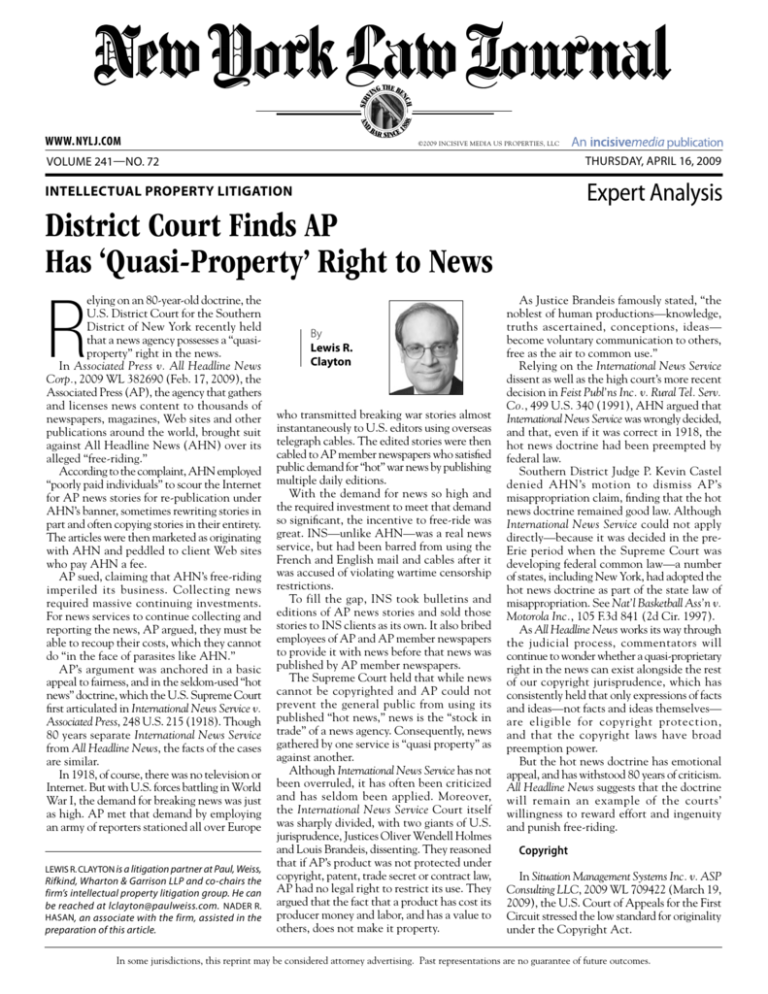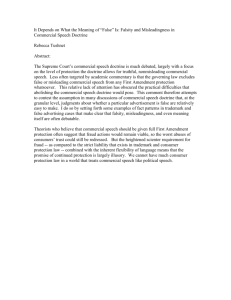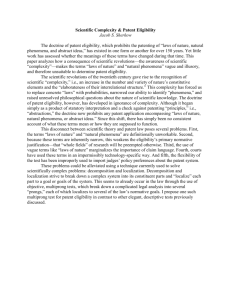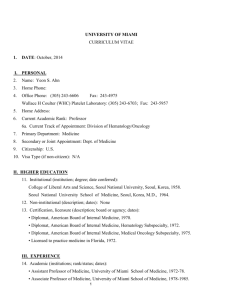
AND
88
8
SER
V
H
NC
THE BE
ING
1
BA
R SINCE
www. NYLJ.com
©2009 Incisive Media US Properties, LLC
Volume 241—NO. 72
thursday, april 16, 2009
intellectual property litigation
Expert Analysis
District Court Finds AP
Has ‘Quasi-Property’ Right to News
R
elying on an 80-year-old doctrine, the
U.S. District Court for the Southern
District of New York recently held
that a news agency possesses a “quasiproperty” right in the news.
In Associated Press v. All Headline News
Corp., 2009 WL 382690 (Feb. 17, 2009), the
Associated Press (AP), the agency that gathers
and licenses news content to thousands of
newspapers, magazines, Web sites and other
publications around the world, brought suit
against All Headline News (AHN) over its
alleged “free-riding.”
According to the complaint, AHN employed
“poorly paid individuals” to scour the Internet
for AP news stories for re-publication under
AHN’s banner, sometimes rewriting stories in
part and often copying stories in their entirety.
The articles were then marketed as originating
with AHN and peddled to client Web sites
who pay AHN a fee.
AP sued, claiming that AHN’s free-riding
imperiled its business. Collecting news
required massive continuing investments.
For news services to continue collecting and
reporting the news, AP argued, they must be
able to recoup their costs, which they cannot
do “in the face of parasites like AHN.”
AP’s argument was anchored in a basic
appeal to fairness, and in the seldom-used “hot
news” doctrine, which the U.S. Supreme Court
first articulated in International News Service v.
Associated Press, 248 U.S. 215 (1918). Though
80 years separate International News Service
from All Headline News, the facts of the cases
are similar.
In 1918, of course, there was no television or
Internet. But with U.S. forces battling in World
War I, the demand for breaking news was just
as high. AP met that demand by employing
an army of reporters stationed all over Europe
Lewis R. Clayton is a litigation partner at Paul, Weiss,
Rifkind, Wharton & Garrison LLP and co-chairs the
firm’s intellectual property litigation group. He can
be reached at lclayton@paulweiss.com. Nader R.
Hasan, an associate with the firm, assisted in the
preparation of this article.
By
Lewis R.
Clayton
who transmitted breaking war stories almost
instantaneously to U.S. editors using overseas
telegraph cables. The edited stories were then
cabled to AP member newspapers who satisfied
public demand for “hot” war news by publishing
multiple daily editions.
With the demand for news so high and
the required investment to meet that demand
so significant, the incentive to free-ride was
great. INS—unlike AHN—was a real news
service, but had been barred from using the
French and English mail and cables after it
was accused of violating wartime censorship
restrictions.
To fill the gap, INS took bulletins and
editions of AP news stories and sold those
stories to INS clients as its own. It also bribed
employees of AP and AP member newspapers
to provide it with news before that news was
published by AP member newspapers.
The Supreme Court held that while news
cannot be copyrighted and AP could not
prevent the general public from using its
published “hot news,” news is the “stock in
trade” of a news agency. Consequently, news
gathered by one service is “quasi property” as
against another.
Although International News Service has not
been overruled, it has often been criticized
and has seldom been applied. Moreover,
the International News Service Court itself
was sharply divided, with two giants of U.S.
jurisprudence, Justices Oliver Wendell Holmes
and Louis Brandeis, dissenting. They reasoned
that if AP’s product was not protected under
copyright, patent, trade secret or contract law,
AP had no legal right to restrict its use. They
argued that the fact that a product has cost its
producer money and labor, and has a value to
others, does not make it property.
As Justice Brandeis famously stated, “the
noblest of human productions—knowledge,
truths ascertained, conceptions, ideas—
become voluntary communication to others,
free as the air to common use.”
Relying on the International News Service
dissent as well as the high court’s more recent
decision in Feist Publ’ns Inc. v. Rural Tel. Serv.
Co., 499 U.S. 340 (1991), AHN argued that
International News Service was wrongly decided,
and that, even if it was correct in 1918, the
hot news doctrine had been preempted by
federal law.
Southern District Judge P. Kevin Castel
denied AHN’s motion to dismiss AP’s
misappropriation claim, finding that the hot
news doctrine remained good law. Although
International News Service could not apply
directly—because it was decided in the preErie period when the Supreme Court was
developing federal common law—a number
of states, including New York, had adopted the
hot news doctrine as part of the state law of
misappropriation. See Nat’l Basketball Ass’n v.
Motorola Inc., 105 F.3d 841 (2d Cir. 1997).
As All Headline News works its way through
the judicial process, commentators will
continue to wonder whether a quasi-proprietary
right in the news can exist alongside the rest
of our copyright jurisprudence, which has
consistently held that only expressions of facts
and ideas—not facts and ideas themselves—
are eligible for copyright protection,
and that the copyright laws have broad
preemption power.
But the hot news doctrine has emotional
appeal, and has withstood 80 years of criticism.
All Headline News suggests that the doctrine
will remain an example of the courts’
willingness to reward effort and ingenuity
and punish free-riding.
Copyright
In Situation Management Systems Inc. v. ASP
Consulting LLC, 2009 WL 709422 (March 19,
2009), the U.S. Court of Appeals for the First
Circuit stressed the low standard for originality
under the Copyright Act.
In some jurisdictions, this reprint may be considered attorney advertising. Past representations are no guarantee of future outcomes.
thursday, april 16, 2009
Defendant ASP Consulting had copied
portions of copyrighted training materials
designed to teach “communication and
negotiation within the workplace” authored
by a competitor, Situation Management.
Deriding the materials as “aggressively vapid—
hundreds of pages filled with generalizations,
platitudes, and observations of the obvious,”
the district court found most of the work not
copyrightable.
Reversing, the First Circuit stressed that
entitlement to copyright protection does not
depend on “the court’s subjective assessment
of its creative worth.” The circuit also found
that the work could not be denied protection
under §102(b) of the act, which declares
that copyright does not extend to any idea,
procedure, process or system. While a system
or process of teaching workplace skills would
not itself be copyrightable, the expression of
such a system or process may be.
Would-be plaintiffs wishing to vindicate
intellectual property rights in state court were
dealt a blow in Scranton Times L.P. v. WilkesBarre Publishing Co., 2009 WL 585502 (M.D.
Pa. March 6, 2009).
Plaintiff Scranton Times sued competitor
Wilkes-Barre Publishing Co. for copying
obituaries originally published in the Times
newspaper and on its Web site. WilkesBarre removed the case to federal court, and
Scranton Times moved to remand, arguing
that it had pleaded only state law causes of
action.
Denying remand, the trial court held that
four of Scranton Times’ claims were in fact
federal law causes of action masquerading as
issues of state law. Citing Franchise Tax Board
v. Construction Laborers Vacation Trust, 463
U.S. 1, 22 (1983), the district court noted
that where a state law cause of action is
“really” a federal cause of action, it may be
removed to federal court “if the federal cause
of action completely preempts the state cause
of action.”
Although Scranton Times had styled
its claims as hot-news “misappropriation,”
state law “unfair competition,” “tortious
interference with existing business relations”
and “unjust enrichment,” these claims were all
examples of copyright infringement couched
as state law claims. The result might have been
different had Scranton Times been able to
convince the court that it had a viable “hot
news” claim.
Lanham Act
While the Lanham Act creates a broad
cause of action for false advertising, such
suits ordinarily cannot be brought based on
advertisements that falsely claim authorship
of an idea.
Baden Sports Inc. v. Motlen USA Inc., 2009
WL 349358 (Feb. 13, 2009), overturned a jury
award of $8.1 million for false advertising.
Baden Sports Inc. owns patents in
basketballs with “raised seams” and padding
under the outer covering,” which it marketed
as “cushion control technology.” Molten USA
Inc. imported a ball that infringed the Baden
patent, claiming its product used “innovative”
“dual-cushion technology.”
Rejecting Baden’s claim, the U.S. Court
of Appeals for the Federal Circuit found
that the term “innovative” merely suggests
that the product was new and says nothing
about how, where or by whom it was made.
Following Dastar v. Twentieth Century Fox Film
Corp., 539 U.S. 23 (2007), such advertising
is not actionable under the Lanham Act.
The Federal Circuit cautioned that §43(a)
of the act is not a federal counterpart of state
unfair competition laws: the provision “does
not have boundless application as a remedy
for unfair trade practices.”
Sound as Trademark
In In re Vertex Group LLP, 2009 WL 625581
(TTAB Feb. 13, 2009), the Trademark Trial
and Appeal Board (TTAB) rejected an attempt
to register an alarm sound as a trademark.
Vertex created AmberWatch, a child safety
bracelet intended to deter abductions. When
activated, it emits a loud warning noise.
Although sounds may qualify for trademark
protection, see In re General Electric Broadcasting
Co., 199 USPQ 560 (TTAB 1978), Vertex
failed to demonstrate entitlement to that
protection.
The Associated Press’ argument
was anchored in a basic appeal to
fairness, and in the seldom-used
‘hot news’ doctrine, which the U.S.
Supreme Court first articulated some
eight decades ago.
First, Vertex failed to show that the
AmberWatch sound had acquired the
requisite “distinctiveness.” Under Qualitex
Co. v. Jacobson Products Co., 514 U.S.
159 (1995), “color and trade dress in the nature
of product design can never be inherently
distinctive and can only be registered on a
showing of secondary meaning.”
Vertex had not shown the sound had
acquired secondary meaning—“it is not clear
that listeners would perceive the sound…to
be anything more than an alarm sound.”
Moreover, a product feature that is functional
cannot serve as a trademark “if it is essential to
the use or purpose of the article or if it affects
the cost of quality of the article.”
Granting Vertex’s application would
improperly put competitors at a disadvantage
by denying them the use of sound frequencies
in the optimal range.
Business Method Patent
In In re Ferguson, 2009 WL 565074 (March
6, 2009), the Federal Circuit handed down
another defeat to the holder of a business
method patent.
The applicants sought to patent a
“paradigm” for bringing products to market,
comprising developing a “shared marketing
force,” including “marketing channels”
that “enable marketing a number of related
products.”
Under the Federal Circuit’s en banc decision
in In re Bilski, 545 F.3d 943 (2008), a process
embraces “patent-eligible subject matter”
under §101 of the Patent Act if it (1) is tied
to a particular machine or apparatus, or (2)
transforms a particular article into a different
state or thing.
Methods such as that claimed by Ferguson—
which “are directed to organizing business or
legal relationships in the structuring of a sales
force (or marketing company)”—fail this test.
A construct such as a “shared marketing force”
does not qualify as a “machine or apparatus,”
and structuring a sales force does not “transform
any article into a different state or thing.”
The Supreme Court’s landmark decision
in KSR Int’l Co. v. Teleflex Inc., 550 U.S.
398 (2007), emphasized the responsibility of
courts to invalidate patents that are obvious
combinations of prior art references.
Stent Claim
In Boston Scientific Scimed Inc. v. Cordis
Corp., 554 F.3d 982 (2009), the Federal Circuit
overturned a jury verdict and declared invalid
several claims of a patent covering a drugeluting stent.
After a close examination of the prior art,
the circuit found that all of the limitations
of the claims were disclosed in two separate
embodiments of stents pictured in Wolff, a
prior art patent.
The court held that “combining two
embodiments disclosed adjacent to each
other in a prior art patent does not require
a leap of inventiveness.” This “strong prima
facie showing” of invalidity was sufficient to
overcome “weak” secondary considerations
of nonobviousness.
While the patentee argued that the failure
of the owner of the Wolff patent to develop the
claimed invention showed the invention was
not obvious, the circuit found that this failure
was due to the inability to find a suitable drug,
not to matters claimed in the patent.
Reprinted with permission from the April 16, 2009 edition of
the NEW YORK LAW JOURNAL © 2009. Incisive Media
US Properties, LLC. All rights reserved. Further duplication
without permission is prohibited. For information, contact
877-257-3382 or reprintscustomerservice@incisivemedia.
com. # 070-04-09-34








